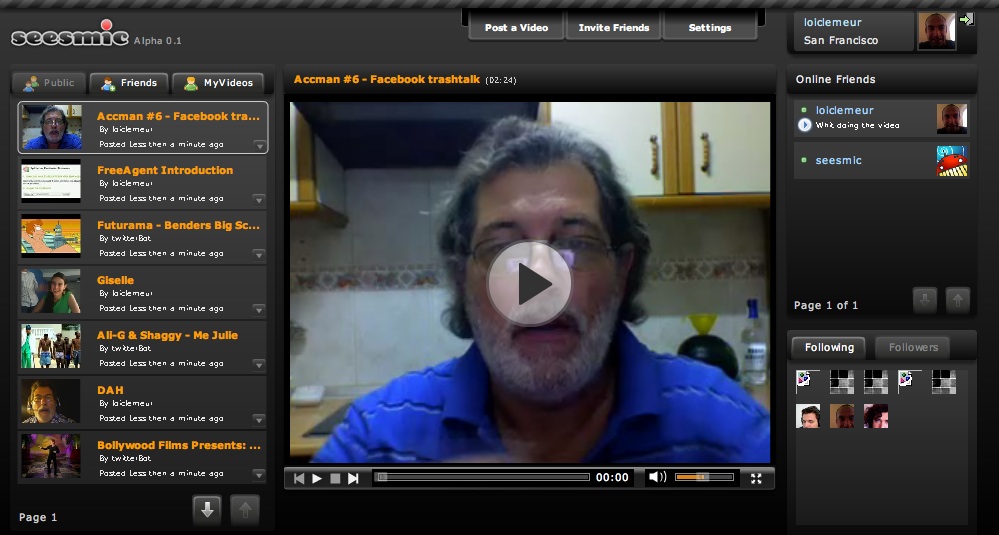Seesmic for enterprise?

Loic LeMeur's Seesmic has the ingredients to be a hit - inside the enterprise. Mike Arrington and Ben Metcalfe have rendered their respective cautious verdicts and it would be remiss of me to sound overexcited. After all, the current iteration is Alpha 0.1 and I expect many changes before the 'proper' beta becomes widely available, expected sometime in November.
My focus is how this service might be used inside the enterprise. We've already seen what Ed Herrmann and Dan McWeeney can do with wiimotes and SAP systems at Majority Desk. If you've not seen the video then it's well worth checking out.
Seesmic is an extension of the general idea that enterprise doesn't have to be dull but can include a fun element while encouraging people to dream up fresh uses. I believe that represents a significant step in making social computing a productivity builder. My sense is that Seesmic has the ingredients for creating a powerful medium that takes the best of Twitter (real time connections to people who matter to you) and adding the video 'edge.' Why should this matter?
The written word is a powerful thing but doesn't always convey the meaning an individual would like to convey. Video solves that problem because you can both see and hear the nuances around a specific statement. Then there is that old saying: 'A picture is worth a thousand words.' Twitter gives you 140 characters. Some will argue that video conferencing provides that facility in a live, real-time setting. True. As the world of work moves more towards problem solving, individuals who are working in dispersed teams will need a better means of personal interaction. In many situations, that requires little more than a few moments with a colleague to help get something done. Seesmic could facilitate that far faster than Twitter and a quantum leap faster than email.
There are other potential uses. It could be used for short product demonstrations requiring instant or fast track feedback inside devleopment teams. What about recruitment, data visualization, maintenance reporting...the list goes on? Or, as Mike Arrington says:
The grand vision behind Seesmic is for it to become a very open online video/television service where people are constantly interacting around both user generated and professional content.
Developers are going to love Seesmic because Loic has made very clear that he envisions Seesmic as a 'technical open platform.' Included within the specification is:
Open data formats:
- RDF as the foundation, and exporters to microformats, HTML, RDFa...
- We already use existing open metadata vocabularies
- FOAF (for friend management)
- SIOC (for community description)
- Dublin Core for description of resources
- In the process of using a subset of MPEG-7 ontology for video metadata.
Open identifiers:
- Public URL scheme, and standardized authentication system. Considering the use of OpenID
Open source technologies:
- Use Open Source projects wherever it's possible.
- Open Source critical pieces of the architecture, to allow for greater long term maintainability of complex pieces of software that are not core to the business and can benefit from the community.
Server Side:
- Java powered Architecture.
- All data exportable to RDF (W3C), addressable by URLs.
- Queries endpoint so people will be able to write their own queries, submit them to Seesmic server and get back results in standardized format.
Client Side:
- Flex client powered by a homemade framework, which allows user written extensions.
Communication:
- REST Style HTTP
- Jabber for real time interaction.
API at several levels:
- Data levels: Allow community to build upon Seesmic API in the technology of their choice, using REST - style queries.
- All Seesmic data will be made available primarily as RDF with exporters to microformats, and various metadata which are still being defined like the OpenFriendFormat
- Client Level: Allow people to develop plugins which will integrate in Seesmic client interface.
- Ultimately we will allow people to store and retrieve their data, into their own format, with the built-in possibility to seamlessly connect with Seesmic vocabularies and data.
Seesmic is only at the beginning of its journey, there is much to be done and as Ben Metcalfe observes:
Of course this is going to be a crowded market, but from what I have seen I think Loic has built a good foundation to launch from. Also, given its strict SMS and IM orientation I doubt very much Twitter will launch into this space - meaning there’s all to play for.
I agree but with one additional observation: Seesmic is first into the market with something that not only satisfies the senses but takes us a step closer to delivering social computing value in a way with which any decision maker can identify. That's a big step forward.
Ben raises the question of context, asking how Seesmic will provide the Twitter style hook of 'what are you doing?' I don't see that as an issue for those who choose to go play with this in the enterprise setting. As we've seen, Twitter has become a lot more than that and has morphed into a useful extension to our methods of communications. At one level, Twitter has become like an unthreaded forum and Seesmic could fulfil the same role. I do however have one big issue.
As currently iterated, Seesmic takes up a lot of screen real estate and I believe it will need to be 'collapsible' so that it doesn't dominate. Just as we don't 'live' inside one application, it is hard to envisage living inside something like Seesmic. The alternative is that like Twitter, Seesmic becomes the center of gravity for developers to find smart ways of representing its capabilities.
